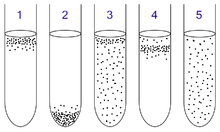- Obligate anaerobe
-
 Aerobic and anaerobic bacteria can be identified by growing them in liquid culture:
Aerobic and anaerobic bacteria can be identified by growing them in liquid culture:
1. Obligate aerobe
2. Obligate anaerobe
3. Facultative anaerobic organism (continuum with "Facultative aerobic organism")
4. Microaerophile
5. Aerotolerant organismObligate anaerobes are microorganisms that live and grow in the absence of molecular oxygen; some of these are killed by oxygen. (adj., anaero´bic., adj.)[1]
Contents
Metabolism
Historically, it was widely accepted[citation needed] that obligate (strict) anaerobes die in presence of oxygen due to the absence of the enzymes superoxide dismutase and catalase, which would convert the lethal superoxide formed in their cells due to the presence of oxygen. While this is true in some cases, these enzyme activities have been identified in some obligate anaerobes, and genes for these enzymes and related proteins have been found in their genomes, such as Clostridium butyricum and Methanosarcina barkeri, among others. However, these organisms are still incapable of growing in the presence of oxygen. There are several hypotheses addressing why strict anaerobes are sensitive to oxygen:
- Dissolved oxygen increases the redox potential of a solution, and high redox potential inhibits the growth of some strict anaerobes. For example, methanogens grow at a redox potential lower than -0.3 V.
- Sulfide is an essential component of some enzymes, and molecular oxygen oxidizes this to form disulfide, thus inactivating certain enzymes. Organisms may not be able to grow without these deactivated enzymes.
- Growth may be inhibited due to a lack of reducing equivalents for biosynthesis, because electrons are exhausted in reducing oxygen.
It is most likely a combination of these mechanisms that accounts for oxygen sensitivity in obligate anaerobes.[2]
Instead of oxygen, obligate anaerobes use alternate electron acceptors for cellular respiration such as sulfate, nitrate, iron, manganese, mercury, and carbon monoxide. The energy yield of these respiratory processes is less than oxygen respiration, and not all of these electron acceptors are created equal.
- In marine sediments large amounts of sulfate-reducing bacteria causes the rotten egg smell and black material that can be found just a few centimeters below the sediment surface.
Examples
Bacteroides and Clostridium species are examples of non-spore forming and spore-forming strict anaerobes, respectively.
Other obligate anaerobes include Peptostreptococcus, Veillonella,[3] and Actinomyces.
See also
References
- ^ "anaerobe" at Dorland's Medical Dictionary
- ^ Kim, Byung Hong and Geoffrey Michael Gadd. Bacterial Physiology and Metabolism. Cambridge University Press, Cambridge, UK. 2008.
- ^ "ANAEROBIC BACILLI". http://www1.indstate.edu/thcme/micro/lectures/anaerlec.html. Retrieved 2009-03-10.[dead link]
Pathogenic bacteria Bacterial disease · Coley's Toxins · Exotoxin · Lysogenic cycle
Human flora Substrate preference Oxygen preference Structures Cell wall: Peptidoglycan (NAM, NAG, DAP)
Gram-positive bacteria only: Teichoic acid · Lipoteichoic acid · Endospore
Gram-negative bacteria only: Bacterial outer membrane (Porin, Lipopolysaccharide) · Periplasmic space
Mycobacteria only: Arabinogalactan · Mycolic acidOutside envelopeCompositeShapes Categories:
Wikimedia Foundation. 2010.
